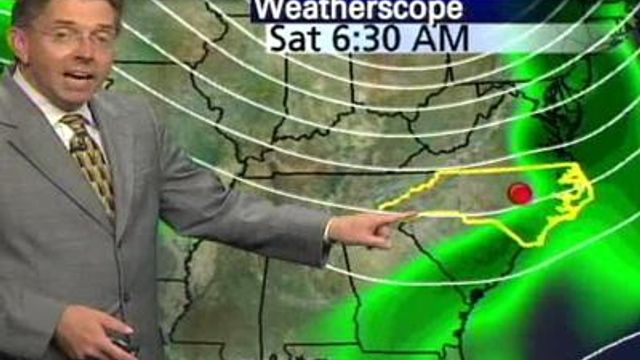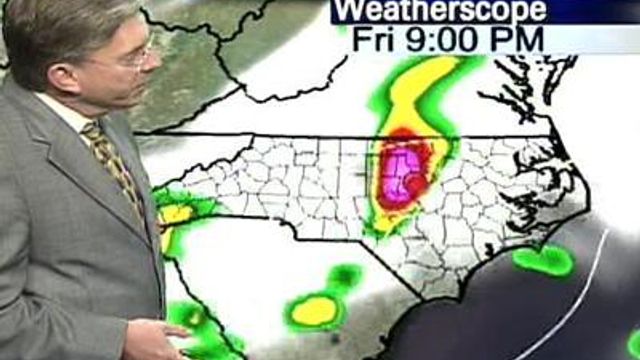Local News
Even Small Help With Drought Is Welcome as Rain Approaches
Weekend rain could bring a bit of relief to North Carolina, where all but two counties are experiencing severe, extreme or exceptional drought conditions.
Posted — UpdatedRALEIGH, N.C. — The Triangle's first significant rain in weeks could put a small dent in the drought parching North Carolina when moisture from what was Hurricane Humberto reaches the area on Friday, forecasters said.
The forecast was greeted as welcome news for a state in which all but two counties are experiencing severe, extreme or exceptional drought conditions and water is short almost everywhere.
"One system, obviously, is not going to end something that's been built up for months and months, but you have to start somewhere, and it looks like we will do that, tomorrow and perhaps even into Saturday," WRAL Chief Meteorologist Greg Fishel said on Thursday night.
The rain probability for the Triangle stems from moisture associated with Humberto, which made landfall in southeast Texas early Thursday as a Category 1 hurricane. The remnants of Humberto were making their way northeast and were forecast to combine with a frontal system over the Southeast.
Significant rain could start falling in the Triangle as early as midday Friday, and areas north of the Triangle might be able to collect an inch, Fishel said on Thursday night.
"I think that everybody will get rain tomorrow. Amounts will vary, as they always do," he said.
"This is, by far and away, the best chance of widespread rain we have had in weeks, and we certainly hope we make use of it, because there may not be a whole lot more coming once we get past Saturday," the forecaster added.
As the Triangle watched for any help from Humberto's remains, the National Hurricane Center in Miami designated a storm system in the Atlantic as Tropical Storm Ingrid. Fishel said, however, that westerly winds would likely tear that system apart before it got near North America.
The forecast for wet weather comes at a time when all of North Carolina's 100 counties, excluding Carteret and Pamlico, are experiencing severe, extreme or exceptional drought conditions, according to the weekly report from the North Carolina Drought Management Advisory Council, most recently issued on Thursday.
Carteret and Pamlico counties are the only locations in the state still considered in a moderate drought.
A dozen counties in the eastern part of the state are in a severe drought, while 75 counties – three-quarters of the state – are in extreme drought.
Eleven counties in the western tip of the state are the worst off, experiencing exceptional drought conditions.
The worsening drought conditions have spread from west to east across the state in recent weeks, withering crops and prompting a growing number of water restrictions by cities and counties trying to preserve their dwindling drinking water supplies.
Tropical Storm Gabrielle gave officials in coastal counties some hope of relief last weekend, but the storm only glanced off the Outer Banks and didn't deliver much rain, except in isolated spots.
Gov. Mike Easley on Thursday renewed his call for water conservation and reminded people to avoid outdoor burning because of a growing fire hazard.
"I do not want us to get to the point where I have to order mandatory water restrictions,” Easley said in a statement. “If everyone across the state will conserve voluntarily, we should be able to avoid a situation where health and safety is threatened, and I have no choice but to enact mandatory measures.”
Mandatory water restrictions are already in place in 66 of the state's public and large private water systems, out of the 593 large and small water systems tracked by the state Division of Water Resources, Easley said. Another 62 systems have enacted voluntary restrictions.
In addition to affecting water usage, the drought is helping fuel wildfires across the state, with the average number of fires already passed, the governor's office said. The state averages 4,931 wildfires on 20,008 acres annually, but 5,555 fires have already burned 31,611 acres so far this year.
The state Division of Forest Resources enacted a ban on open burning August 21.
Easley also asked the U.S. Department of Agriculture to declare much of the state a disaster area because of crop losses due to drought. In 85 counties, at least one crop has been affected by the drought.
Copyright 2024 by Capitol Broadcasting Company. All rights reserved. This material may not be published, broadcast, rewritten or redistributed.






